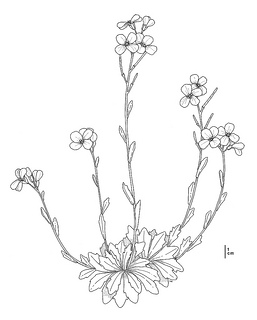(Arabis mcdonaldiana)
-Norman-Jensen-small.jpg) Arabis mcdonaldiana. Photo by Norm Jensen, by permission, Jensen Family Memorial Trust.
Arabis mcdonaldiana. Photo by Norm Jensen, by permission, Jensen Family Memorial Trust.
 Arabis mcdonaldiana. CDFW illustration by Mary Ann Showers. (Click to enlarge)
Arabis mcdonaldiana. CDFW illustration by Mary Ann Showers. (Click to enlarge)
McDonald’s rock cress is a California endangered plant species, which means that killing or possessing the plant is prohibited by the California Endangered Species Act (CESA). McDonald’s rock cress is a perennial herb native to Northern California. Its tall flowering stems arise from a flattened rosette, and it blooms with large lavender to purple flowers between May and June. McDonald’s rock cress is also listed as endangered under the federal Endangered Species Act(opens in new tab).
McDonald’s rock cress is endemic to Red Mountain in Mendocino County, where it was first described. It was thought to be rediscovered later in Del Norte County, and for many years there was disagreement about the taxonomy of the Del Norte Arabis populations. As described in the 2013 U.S. Fish and Wildlife Service 5-Year Review (PDF)(opens in new tab) for the species, the taxonomy has been clarified by recent research. In 2012, Danica Harbaugh-Reytnaud and Linda Ann Vorobik conducted genetic work on the Arabis group and determined that the Red Mountain population was taxonomically distinct and should be treated as Arabis macdonaldiana, while the Del Norte populations belong to a different species, yet to be determined. Therefore, McDonald’s rock cress only occurs on Red Mountain, and there are five occurrences that are thought to still exist at the time of this webpage posting.
McDonald’s rock cress has very specific habitat requirements, and is therefore restricted to a small range. McDonald’s rock cress grows in serpentine soils that are rich in magnesium, silica, iron, and small amounts of nickel. Plants that grow in serpentine soils have adapted traits that allow them to grow in soils with heavy metals that other plants are unable grow in. Other serpentine soil specialists outcompete McDonald’s rock cress, so it only grows in areas that are otherwise unoccupied, such as rock crevices and steep, bare slopes. Associated forest stands include various mixes of ponderosa, Jeffrey, and sugar pine, and incense cedar. There are several other rare plant taxa that are associated with McDonald’s rock cress habitat, including Kellogg’s buckwheat, Red Mountain stonecrop, Red Mountain campion, Engelmann’s lomatium, redwood lily, and California lady’s slipper.
According to the 1984 U.S. Fish and Wildlife Service Recovery Plan (PDF)(opens in new tab), mining was the greatest anthropological threat to McDonald’s rock cress. However, after the recovery plan was written Red Mountain Wilderness was established, significantly reducing the threat of mining to McDonald’s rock cress populations. Some of the habitat is still privately owned and therefore possibly at risk if mining is conducted, but so far no mining has taken place. McDonald’s rock cress could also be threatened by the encroachment of woody species into its habitat due to many years of fire prevention. Climate change and lack of genetic diversity also threaten McDonald’s rock cress. To ensure the endurance of McDonald’s rock cress, existing populations should be protected from mining activities, and field studies should be conducted to assess the negative effects of woody species encroachment, and to monitor the abundance of current populations.
CDFW may issue permits for McDonald’s rock cress pursuant to CESA, and you can learn more about the California laws protecting McDonald’s rock cress and other California native plants. Populations of McDonald’s rock cress occur in CDFW’s Northern Region. More information is also available from the U.S. Fish and Wildlife Service Species Profile for McDonald’s rock cress(opens in new tab).
Updated 06/18/2013